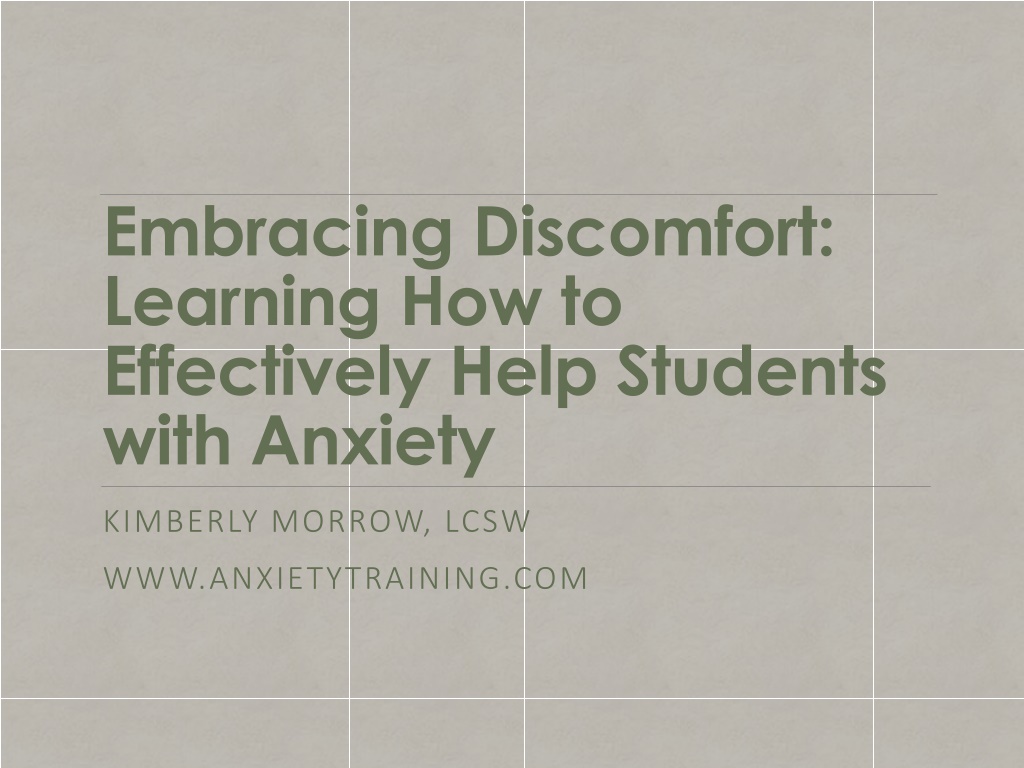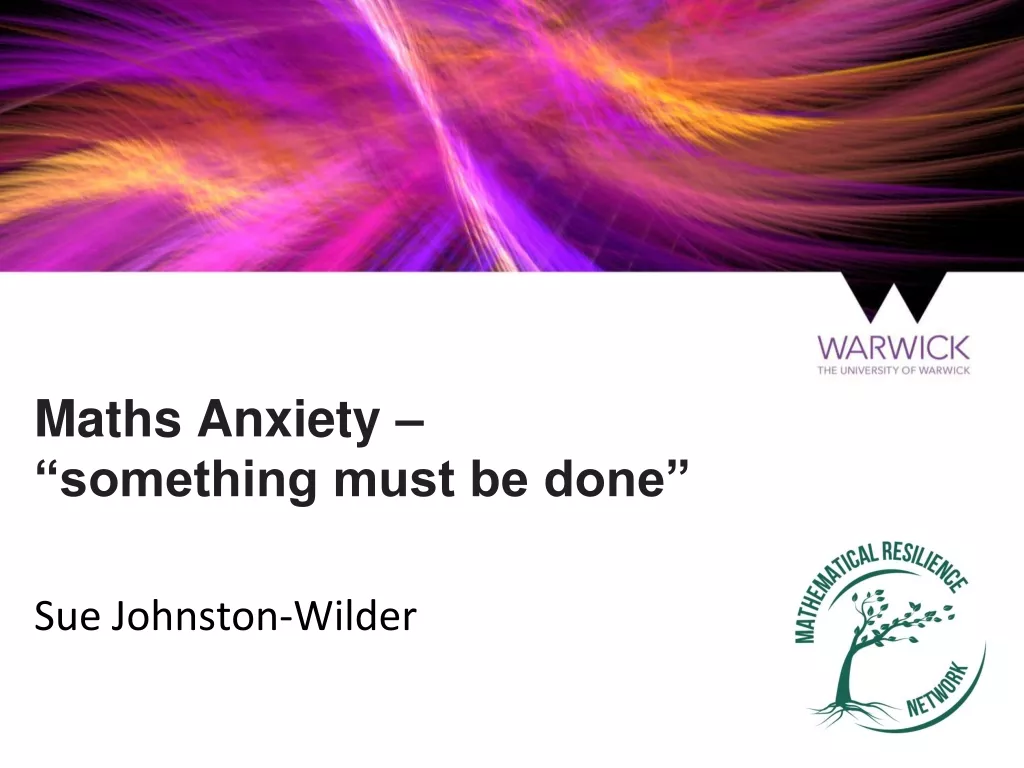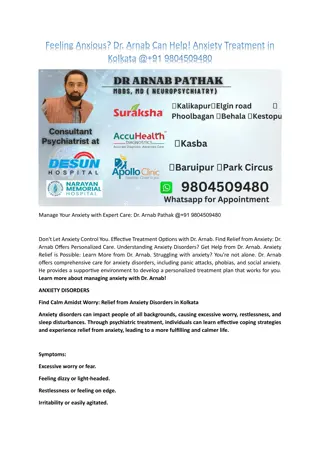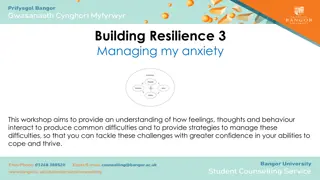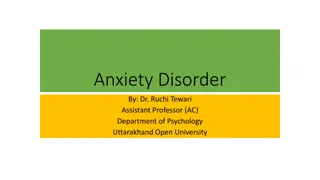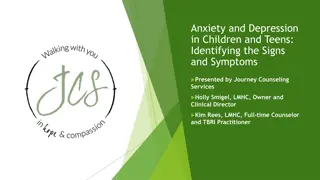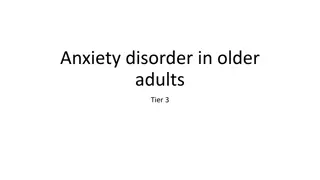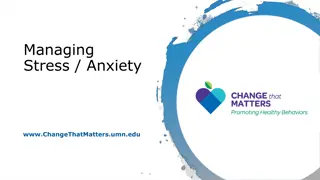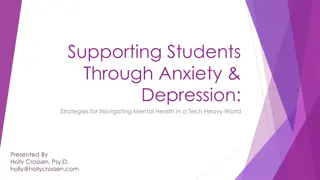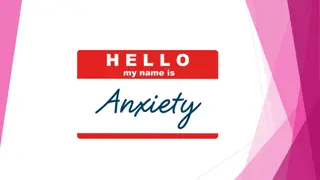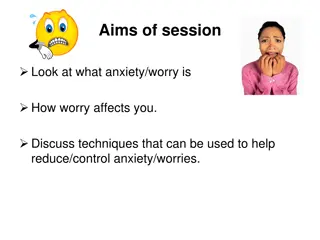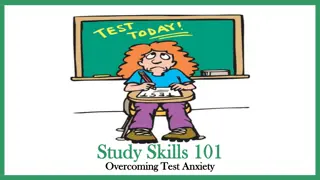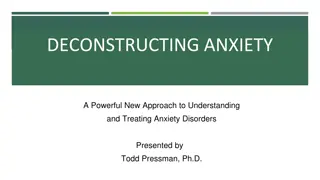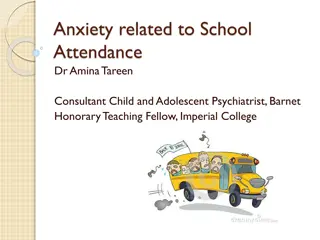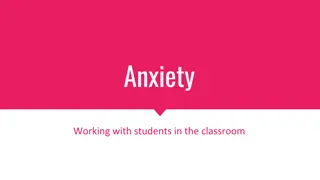Understanding and Supporting Students with Anxiety
This presentation focuses on helping educators understand and effectively support students with anxiety. It covers recognizing anxiety in children and teens, identifying anxiety-related behaviors in the classroom, the role of medication, and approaches to treating anxiety. Strategies such as education, exposure and response prevention, and challenging automatic thoughts are discussed, along with the importance of developing a wellness plan. The speaker, Kimberly Morrow, shares insights on embracing discomfort and the paradox of anxiety to provide valuable tools for managing anxiety in students.
Download Presentation

Please find below an Image/Link to download the presentation.
The content on the website is provided AS IS for your information and personal use only. It may not be sold, licensed, or shared on other websites without obtaining consent from the author. Download presentation by click this link. If you encounter any issues during the download, it is possible that the publisher has removed the file from their server.
E N D
Presentation Transcript
Embracing Discomfort: Learning How to Effectively Help Students with Anxiety KIMBERLY MORROW, LCSW WWW.ANXIETYTRAINING.COM
Speaker Disclosure: Financial: Kimberly Morrow is in private practice. She receives a speaking honorarium from PESI, Inc. She sells courses on AnxietyTraining.com. Nonfinancial: Kimberly Morrow is a member of the National Association of Social Workers, the Anxiety and Depression Association of America, and the International Obsessive- Compulsive Foundation.
Understanding Anxiety in Children and Teens Genes, Temperament, Busy Life Accommodations from parents/teachers Developmental considerations Sensitivity to anxiety Focus on their future Social media
What does anxiety look like in the classroom? Inattention and restlessness School attendance problems and clinginess Disruptive behavior in the classroom Trouble answering questions in class Frequent trips to the nurse or bathroom Won t turn in homework Won t socialize, eat in the lunchroom or participate in group
The Role of Medication Selective Serotonin Reuptake Inhibitors Benzodiazepines Self medicating: Alcohol/marijuana
Treating Anxiety 1. Education 2. Exposure and Response Prevention 3. Challenging Automatic Thoughts 4. Developing a Wellness Plan
Trigger Situations SUDS TRIGGER 10 Meeting new people 8 Eating in the cafeteria 10 Giving a presentation 7 Going to a party 6 Go to a sporting event 5 Answering the phone 9 Answering a question in class
Values-They need a reason to do hard work of facing fear What is important to me? What does anxiety prevent? 1. Sports 1. Can t go to events 2. Friends 2. No friends 3. Family 3. Messing up family 4. Education 4. Not in school 5. Religion 5. Can t go to church
Exposure and Response Prevention Do the thing that scares you by bringing it closer and being curious Accept that there will always be excuses and discomfort. If you listen to them your life will be small, if you do the harder thing you will grow and learn how to handle discomfort. Start small or go big, either way you will get better. Trust the process: Turning towards triggers, riding the wave of anxiety, waiting to respond until wise mind shows up. Your brain will learn what you teach it as long as you are consistent, frequent and intense
Goal: To Be Effective (not symptom free)
I Can Handle It! UNCERTAINTY DISTRESS
Changing the way we think 1. Anticipatory Anxiety 2. Automatic Thoughts 3. Cognitive Distortions 4. Bossing Back 5. Just a Thought 6. Bring it On
Anticipatory Anxiety The only way your brain can prevent you from going into danger The strongest experience with anxiety is before you do the thing that causes anxiety Tell yourself, Of course I feel anxious, I am about to do something that is uncomfortable!
Challenging Automatic Thoughts Getting the (wrong) information: (resistance) Situation: I went to the football game with some kids. Action: Kathy started talking to Jen and I didn t talk. Automatic Thought: Talking to people sucks. I can t do this. I look stupid. They don t even like me. Feeling: I feel like an idiot. I shouldn t have gone. Challenging Automatic Thoughts: (acceptance) Rational Thought: I have difficulty talking to people. I did do this even if it felt bad and wasn t perfect. I don t know how I looked, I only know I felt anxious. I will have to wait to see if they like me. Action: I will text them and tell them I had fun with them. Feeling: Proud I went even though it was hard
Cognitive Distortions Just because I think it doesn t make it true Just because I feel it doesn t make it dangerous Our glitchy brains give us bad information- our mistake is taking action steps on these distorted thoughts Our goal is to take action steps towards what we value
Bossing Back Help them change the way they talk to anxiety so they are in the driver s seat. That s anxiety, it doesn t deserve a response! You re not helping me. I m going to ignore you. Change the way you talk to the student: I hope you feel anxious today! (wink, wink)
Staying present Label Just a worry. Just a fear. Just a feeling. What if What is I m not having a conversation about the future, right now I am studying. Stick to the facts not the fears
Bring It On! Chase after the fear If you want to think about it less, think about it more to teach your brain it s just a thought and you can handle it Be curious and bring the fear closer I m going to the mall with my friends. I hope I feel anxiety because that will give me a chance to teach my brain that I can handle it! I m not going to hand in my assignment so I can learn how to handle getting into trouble!
Climb Over Obstacles Don t wait for it to feel better .. Identify the obstacles and help them to climb over
Safety Behaviors Help them to stop using these: Going to the bathroom multiple times Avoiding eye contact Texting their parent in class Avoiding Going to the nurses office Washing their hands over and over Asking the same question multiple times Seeking reassurance
Coaching Steps 1. Do not reassure someone who is anxious, instead validate how they are feeling and help them tolerate the distress until they are on the other side. Instill in them your belief that they can handle feeling bad. Celebrate trying and any step they make towards handling the feelings. Help them face their fears and be courageous. Don t connect to content. Stay in the doubt (maybe, maybe not I don t know) Answer questions one time to provide information not reassurance. 2. 3. 4. 5. 6. 7.
Develop a Wellness Plan Our brains need a rest . What keeps me well? Why am I doing _________? Practice wellness consistently, not in response to anxiety. (can class begin with this?) Exercise Yoga Mindfulness Meditation (Headspace, Buddhify) Talking in a healthy way to ourselves (Woebot)
Facing Panic Educate student about anxiety and the brain David Carbonell (anxietycoach.com) A.W.A.R.E. Use senses to stay grounded Engage in conversation while tolerating the symptoms Notice the time-15 min rule Interoceptive Treatment to induce panic symptoms Breath-longer exhale Healthy self talk Know the anatomy of a panic attack (see handout) Move-take a walk but return to the classroom
A.W.A.R.E. Acknowledge & Accept (most important) Wait & Watch (gather info, return to task) Actions(Belly breathe, self talk, sensations) Repeat End Difference between being afraid and being in danger.
Social Anxiety: Tolerating Embarrassment Exposure to embarrassing experiences or places where they may be negatively evaluated Social mishap exposures Ask a stranger for directions Ask for directions to a room you are standing right in front of Text something to the wrong person Practice giving wrong answer in class Challenge beliefs about what other people think of you (get facts not fears) Reward students who try and struggle TedX: Till Gross-How to Become More Confident in 30 Sec
School Refusal Teach everyone about anxiety and the brain! Team approach Psychological assessment-other problems? Small steps (be creative and flexible with solutions) Get them involved in an activity they like Ask teacher to be a mentor Begin where they can be successful Involve friends to text/show up The longer they are out of school the harder it is
Test Anxiety Over prepare Don t compare Good self talk Loving kindness Practice timed tests
Obsessive-Compulsive Disorder Obsessions: intrusive images or fears Compulsions: anything you do to feel better What it may look like in school: Reassurance seeking Perfectionism Re-reading/rewriting Asking questions over and over Checking Extensive hand washing Avoiding
How to help students with OCD Accommodations can be helpful until they begin ERP therapy: Seating arrangement: Ask the child where they prefer to sit. Extended time for tests and papers: If writing is a problem for a child who needs to find the perfect way to say something, he s going to need more time to finish those essay questions or papers. Laptops for writing: If writing and rewriting/erasing is really problematic for a child, consider letting her use a laptop for taking notes, and having all assignments be typed instead of handwritten. Private testing rooms: Research is quite clear that kids with OCD do better, are less overwhelmed and are more in control of their thoughts and their reactions if they re in a quiet place away from the other kids.
Helping students with OCD Skip reading out loud: Kids who feel they need to read perfectly may have to go back and reread sentences or whole paragraphs over and over to make sure they ve got them right. So reading becomes a very laborious task, and reading in front of the class can become a nightmare. So if we know doing this is a problem for children, we can spare them. Books on tape: If kids get so hung up reading that it takes forever, listening to the books can be a solution. Break homework into chunks: If looking at a whole page of math makes kids feel overwhelmed and anxious think of the potential for mistakes! the problems can be broken up over four pages. It helps kids stay focused on doing the problems instead of worrying. Our goal is to use exposure therapy for each student with OCD to eventually face their fears and handle these triggering situations without accommodations.
PANS or PANDAS Pediatric Acute-Onset Neuropsychiatric Syndrome (associated with Strep) (1 in 100 children) Strong stimulant (strep, flu, virus, lyme) to the immune system Creates an inflammatory response in the basal ganglia Exact Date Anxiety/OCD Symptoms include severe anxiety (worries, separation, OCD) Along with: reading/writing difficulties, tics, eating disorder, personality change, irritability/aggression, developmental regression See handout
Generalized Anxiety Disorder These are the worriers. They fear not being able to handle bad things in the future. They may ask questions over and over: Give them pennies. When they run out of pennies, they cannot ask more questions. They may seek reassurance: Reassure them one time and then redirect them and don t keep talking with anxiety. Have them write a fear script and coping script and record it into their phone. Listen to this several times a day. Help them tolerate uncertainty: Maybe maybe not. Encourage them to believe they can handle the outcome. Teach these kids to practice presence-worry lives in the future.
Fear vs Coping Script FEAR:I wake up in the morning and I remember what happened yesterday. Julia made fun of me in front of everyone. I was mortified. I don t want to go to school today. I stay in bed, hoping my parents won t make me go. I turn off my alarm. I try to go back to sleep so I don t have to face the day but I lay there worrying about what everyone is thinking. COPING: I wake up in the morning and I remember what happened yesterday. Julia made fun of me in front of everyone. I feel anxiety in my stomach and I wish I didn t have to go to school today. But today I will not let my anxiety or Julia keep me from doing what is important to me. I have a track meet tonight. I need to go to school so I can run in the meet. Running with my friends is more important than anxiety or Julia. I m getting up now, eating a healthy breakfast and will listen to my playlist that makes me feel awesome! Julia has no power over me.
Targeted Anxiety Treatment Group 1. Identify anxious students that are not benefitting from universal support strategies with teachers/counselor 2. Develop program to teach skills and provide peer support 3. Identify day/time to provide program 4. Include parents for a psychoeducation program
Resources SCARED Anxiety Assessment: http://www.midss.org/content/screen-child- anxiety-related-disorders-scared Noises in Your Head Free Video Series Till Gross-Ted x talk: How to Become More Confident Mark Freeman-The OCD Stories on YouTube AnxietyCoach.com Woebot app-to help you get through challenging situations Headspace app-meditation Coaching Handouts Anatomy of a Panic Attack Handout https://childmind.org/guide/a-teachers-guide-to-ocd-in-the-classroom/ PANDAS and PANS Essential Facts for Teachers Handout
